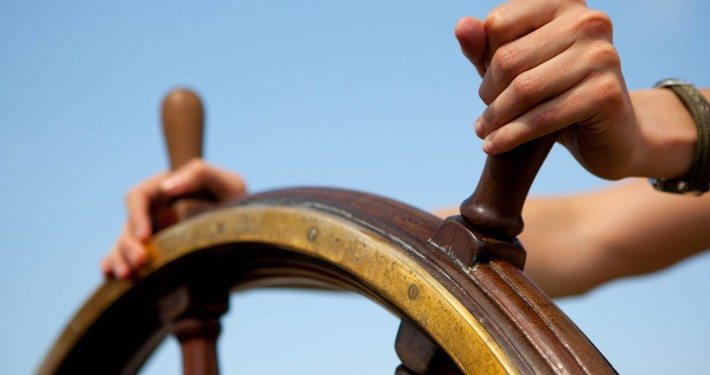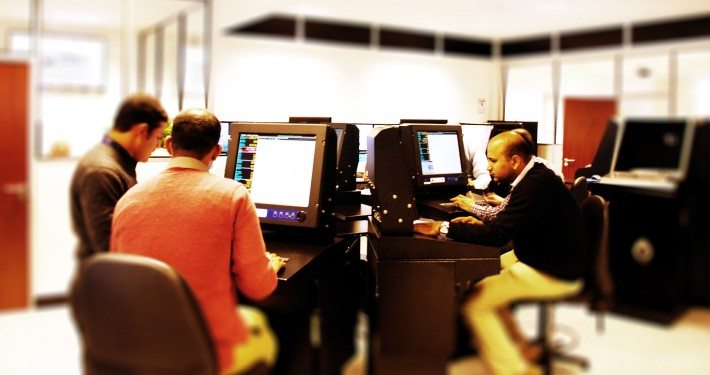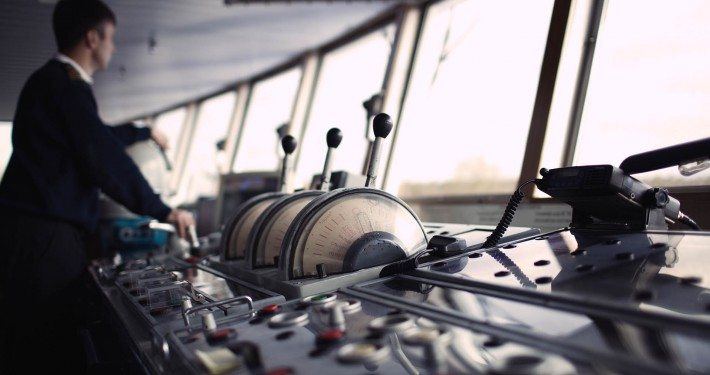Introduction
The emergence of new technology in the field of warfare has seen most facets of naval operations computerised or digitised in the quest to build, display and manipulate the Recognised Maritime Picture (RMP) to our advantage. It is therefore surprising that many military fleets are still navigating using paper charts, as the advantages and efficiencies available if ECDIS systems are used properly for navigation are significant. Furthermore, by enhancing such systems with additional functionality for war fighting (WECDIS) the operator is provided with the tools, overlays and information required to efficiently protect and ultimately fight the ship.
Following the high profile grounding of HMS Nottingham, the Royal Navy (RN) made the bold decision to embark on a Fleet wide WECDIS fit. As the first navy to do so, they have pioneered the use of WECDIS at sea and to date have not incurred a WECDIS related collision or grounding. In short, the RN has shown that it is feasible to trust this new technology and make it work. However, for those that wish to follow the example of the RN the task can seem more than a little daunting. Faced with a blank piece of paper you now need to formulate a plan to ‘go digital’.
Going Digital
The transition to digital is not a case of simply buying any ECDIS system and hoping for the best. This may seem the easiest option, but I can assure you that what looks like the light at the end of the tunnel is the headlight of an oncoming train. Instead, this should be viewed as a major project that requires significant thought and planning. The process can be simplified if we break it down one step at a time to ensure that all data is captured:
Step 1 – Capability Requirement i.e. Establish what you need.
Step 2 – Additional Requirement i.e. Consider the wider implications.
Step 3 – Consolidation i.e. Have we missed anything?
Step 4 – Equipment Purchase and Fit i.e. Make a decision on equipment and fit programme.
Step 5 – Training i.e. Start training.
Step 6 – Digital Transition i.e. Go paperless.
Step 1 – Capability Requirement
First, it is necessary to establish exactly what you need with regard to the WECDIS, both in terms of navigation and operational. The point is that making the digital transition in the military is far more complicated than for a vessel that simply travels from port to port. Due consideration must be given to thinking through all the evolutions that were conducted using paper charts to ensure that they can be achieved on WECDIS with suitable back up, redundancy and the robustness that is required in the military. A list needs to be made of what your expectations are from the WECDIS. If they cannot be met, will you ever truly be able to ‘go digital’?
Navigation
Essentially, you must consider whether or not you wish to transfer your existing paper navigational methods and procedures to WECDIS. If so, with regard to the equipment, ask yourself the following (not exhaustive and in no particular order):
- Can we plan berth to berth?
- Can we utilise headmarks, sternmarks and beam marks in our planning?
- Can we utilise wheel over bearings?
- Can the system construct accurate turns utilising Advance and Transfer?
- Can the system calculate turns when a tidal stream is present?
- Will it accept tidal and environmental information such as Admiralty Total Tide?
- Can it utilise our shape, characteristics and hydrodynamic data for precise navigation?
- Who will produce and input ship specific (perhaps confidential) information into the system?
- How will the navigator brief the port entry and exit if there is no paper chart to display?
- Can we network a printer to print out screenshots (for the navigator’s notebook, for example)?
- Can we print out passage plans and related information?
- How are we going to operate in areas of GPS denial?
- Does it work well without GPS?
- Can we manually fix position with visual bearings?
- Can we manually fix position with radar ranges?
- Can we plot a position using transferred position lines?
- Can we plot horizontal and vertical sextant angles?
- Can we accurately define safe water in confined waters?
- Can we construct Limiting Danger Lines?
- Can we construct Clearing Bearings?
- How will navigation be conducted in emergency for example, when operating from the emergency conning position without paper charts?
Of course, not all considerations above will be relevant to you, but care must be taken to ensure that the requirement is captured as not all systems can achieve all of the above list.
Operational
With regard to the operational aspect of WECDIS, consider the following (not exhaustive and in no particular order):
- How are we going to plot our helicopter position?
- How are we going to plot the location of a possible submarine?
- How are we going to plot the location of our seaboat, landing craft or tenders?
- Can we use the system for waterspace management?
- Can we display moving havens?
- Can we display weapon arcs?
- Can we display enemy weapon arcs?
- Can it display Additional Military Layers (AML) that we may require for tactical purposes?
- Does it offer greater security with regard to login?
- Can I plot different grids for operations with NATO and for NGS?
- Can it help with Force Protection?
- Can it utilise recognised tactical symbology?
- Can it display military exercise areas?
- Can it make areas alarmable?
- Can we feed RMP data from command systems in order to improve special awareness?
- Can it be used in conjunction with optimum route planning software?
- Can it be used in conjunction with shipping databases such as Lloyd’s Register Fairplay?
- Can the system predict a MOB position using set and drift or is it just a reference point?
Submarines
- Is the system appropriate for use on submarines?
- Can we conduct dived navigation on this system?
- Can we fix using bottom contours?
- Can we fix using Pool of Errors (POE)?
- Can we use Target Motion Analysis (TMA)?
WECDIS equipment capability has advanced considerably over the years and varies from system to system. Not all systems will be able to achieve the above lists, but some can. At this stage please consider taking free independent advice from ECDIS Ltd as to the most appropriate system for your needs. However, to reiterate, first and foremost the system will be utilised as a navigation aid. Therefore, it is vital to ensure that the system can reflect your standards of chart work and navigation. If it cannot, then you may have to change your tried and tested methods. Consider that if the chosen system cannot achieve your requirement, you may be forced to dust off the old paper charts when entering a tactical scenario. This would clearly defeat the aim, which is after all, to go fully digital.
It is at this early stage that a decision needs to be made as to whether the plan is to equip the fleet with a single equipment solution, or whether different types of equipment spread amongst the fleet will be considered. Clearly, the ramifications of fitting your fleet with varying types of equipment will be enormous, from different levels of capability and an inability to transfer data between systems, to the need to produce multiple training streams for crews, technical training for engineers and so on.
Step 2 – Additional Requirement
Experience has shown me that the cheapest option on paper may end up being the most expensive overall when you add in the other elements beyond the initial hardware tender. Training, for example is a significant factor, as is integration of existing sensors and the tactical use of Warship AIS (WAIS). It may be too late to change once you have bought for the fleet so this is where you must ensure the longevity of your system and do as much as possible to future proof it. Ask yourself again, what do you want the WECDIS to do? Let us now consider the bigger picture (not exhaustive and in no particular order):
Hardware
- Is there an ECDIS system that best suits your class of ship?
- How many vessels require fitting with ECDIS?
- What is the cost of fitting?
- Where are the vessels going to be fitted (fit cost may vary dependent upon location)?
- How many systems do you need – two per ship?
- What screen size do you require for the display?
- What are the requirements for display power, housings and brackets?
- What is the support package available?
- How long does the warranty last?
- Will the systems be networked on a LAN?
- Do you want an additional remote terminal for planning or emergencies?
- Do you need repeats in the CO’s cabin, charthouse or operations room?
- Do you need a repeat in the machinery control room for MARPOL purposes?
- How much are additional software licenses?
- How long does the warranty last?
- How much are the inevitable upgrades to the software and presentation library?
Integration
- Do you require integration with a bridge Alarm Management System?
- Can it integrate with existing sensors such as GNSS, Log, Gyro and Echosounder?
- Can it integrate with existing Radar and provide Radar Image Overlay (RIO)?
- Can it integrate with NAVTEX?
- Can it integrate with the existing autopilot or Track Control device?
Remember that the Performance Standards for ECDIS (IMO A.817(19), revised by MSC 232(82)) state that as a minimum, ECDIS should be connected to the ship’s position fixing system, to the gyro compass and to the speed and distance measuring device. Note that for ships not fitted with a gyro compass, ECDIS should be connected to a marine transmitting heading device. When connecting to additional sensors, ECDIS should not degrade the performance of any equipment providing sensor inputs, and the connection of optional equipment should not degrade the performance of ECDIS below the set standard.
Software
- Do you need specific planning software?
- Do you require Conning and Docking functionality?
- Do you require navigation tools such as Predictor and Trial Manoeuvring?
- Do you require an electronic Logbook function?
- How much are additional software licenses?
- How much are the inevitable upgrades to the software and presentation library?
Tactical
- Do you want live and secure WECDIS to WECDIS communications?
- Do you want an additional remote terminal for planning or emergencies?
- Do I want equipment that is likely to be fitted throughout the fleet of my allies to promote more joint planning during operations or exchanges?
- Do you need to exploit AIS by using WAIS?
- Do you want to store spare parts to support your fleet?
- How much are spare parts?
- What is the availability of spare parts?
Charts and Miscellaneous
- Can the manufacturer provide equipment procedures and check-off cards?
- Can the system utilise the charts that you are used to?
- Do you require ENCs and RNCs?
- Do you require DNCs?
- Do you require Ice charts?
- Can it display the Admiralty Information Overlay?
- Will you require an additional (appropriate) folio of paper charts?
- How will folios be updated?
- Will the systems be linked to the internet for updating purposes?
- If connecting to the internet an approved firewall and antivirus protector are required.
- Can you be assured of confidentiality on the project with all the interested members?
Training
- Is there ‘on site’ training available with the manufacturer?
- If not, where can I train my personnel on this equipment?
- What standards of training are required – STCW?
- Is there an option to purchase the approved training courses from the manufacturer to save the cost of time and money in producing one ‘in house’?
- Can I pay a ‘per head’ cost to have personnel trained on site and simply offset the entire headache of purchasing and developing an ‘in house’ solution?
- Do we require technical training for our engineers?
Training is integral to a successful transition from paper charts to WECDIS. Crews need to be properly trained in the use of their system in order to navigate safely and ultimately to fight the ship. This is not something that can be taken lightly as training cannot be conducted in a few hours. WECDIS presents a step change in the way we conduct navigation at sea, and as a critical system this needs great care and consideration in order to get the most out of the equipment whilst maintaining safety. The following courses will be required:
- A Flag State approved IMO 1.27 Model ECDIS Course (40 hrs or 5 days).
- Equipment Specific training course if different manufacturer’s equipment has been fitted (recommended duration 8 hrs or 1 day).
It is essential that training is considered well in advance of the WECDIS fit to reduce the period of time between training and onboard use to avoid skill fade. Note that some Flag states such as the MCA now require equipment specific training in addition to the 5 day generic ECDIS training course. This ECDIS ‘ship specific equipment training’ should relate to the make and model of the equipment fitted on the ship on which they are currently serving. That is to say, it will be necessary to attend a training course for each different system a Master or Navigation Officer is expected to operate. Although this has been part of ISM for some time, the MCA specifically states that ‘trickle down training’ (i.e. one officer training another) is not acceptable as, inevitably, it leads to incomplete knowledge of the equipments capabilities, and especially the lesser used functions, being passed on.
It can be seen therefore, that the training burden is significant if multiple systems are in use throughout the fleet and where Flag State approved generic training is not available on your chosen system. Due consideration must also be given to the fact that the above courses are not necessarily for life as they may need to be undertaken at stated intervals or if the equipment significantly changes.
The training element is going to take a lot of time, particularly with a large fleet. However, you do not need to wait for the fit programme to start before embarking on the training programme. By doing so you will alleviate pressure and have trained personnel ready to begin the next phase of the project.
It is worthwhile trying to keep this as simple as possible by having the equipment and training providers working together as this makes life much easier. Keeping the number of interested parties to a minimum is surely the safest way to ensure confidentiality and efficiency?
Step 3 – Consolidation
Now take a step back and make sure that we are not missing anything before we purchase the equipment. What are the key elements that must be satisfied when choosing your WECDIS? You must be able to place a tick in the box next to all of the below questions at the beginning of this adventure, or you are slowly heading towards the inevitable disaster! With regards to the equipment:
| Is it ready now? |
|
| Is it type approved ECIDS? |
|
| Can it deliver military symbology? |
|
| Can it integrate with existing sensors? |
|
| Can it employ my navigation techniques? |
|
| Does it offer proven pedigree and global support? |
|
| Will it come with a full military edged training solution? |
|
| Have I balanced the best product with the overall price? |
|
| Is it ‘future proof’ and easily upgradable for new techniques? |
|
| Will the whole package allow my fleet to ‘go digital’ with minimum fuss? |
|
Step 4 – Equipment Purchase and Fit
All the work conducted producing the requirement is now complete and the effort expended will hopefully be rewarded. The next stage is to make a decision on which equipment is the most appropriate for your needs, based upon the work conducted in the earlier steps. If you are intending to conduct training ‘in house’, then consider Step 5 prior to purchasing equipment as there are additional purchases and considerations to make. Once the decision is made the equipment can be purchased.
When constructing the fit programme consider what ships will be fitted first and last. Of course, this may ultimately depend on the fleet operations, maintenance and refit schedule. It is worthwhile documenting lessons learnt from the first fit so that mistakes are not duplicated throughout the fit. Furthermore, maintain some form of continuity of fit personnel to ensure that standards are maintained with as few irregularities between ships as possible. Once equipment is fitted it is essential that the equipment is properly integrated with sensors, aligned with Radar Image Overlay (RIO) and tested with a set to work package to ensure that what you have got is what you have bought.
Step 5 – Training
Training is one of the most important aspects of the entire process. It is a fact that some military vessels are under no obligation to conform to STCW training requirements, but most do. Perhaps it is because they want to give their personnel a recognised civilian accreditation, or because they are nervous about the legal outcome of a collision at sea, or because they want to exceed the highest standards and not cut corners. Either way, you must consider the time and manpower cost of producing the following:
- A stand alone ECDIS course, bespoke for the equipment purchased.
- A course to teach the WECDIS element, bespoke for the equipment purchased.
- Gaining Flag State Course approval.
- Classroom equipment and training consoles.
- Training licenses for software.
- Provision of a bridge simulator.
- Integration of ECDIS into the bridge simulator.
- ECDIS/WECDIS instructors.
All the above takes considerable time, money and most importantly expertise. I cannot emphasise enough the importance of considering training at the very beginning of the process.
Generally speaking, the military have specialist roles on board that will need to use the equipment in very different ways. Therefore, it is a recommendation that such individuals receive bespoke training elements. The following courses and elements may be required:
Courses
- A Flag State approved IMO 1.27 Model ECDIS Course (40 hrs or 5 days).
- Equipment Specific training course if different manufacturer’s equipment has been fitted (8 hrs or 1 day).
Elements
- Commanding Officers – Commanding Officers are required to check and approve the navigation plan. To that end a module is required that teaches Commanding Officers how to check an ECDIS plan. This can be accomplished by providing a plan with potential errors as an assessed serial. Quality controlling an ECDIS plan in my experience is more difficult than a paper equivalent and therefore must be taken seriously.
- Navigating Officers – Having completed the generic IMO 1.27 ECDIS course, a new Navigator will undoubtedly require a short module on how to Pilot the vessel utilising the ECDIS. Navigation courses will have to be changed from being paper chart based to using ECDIS.
- Officer of the Watch (OOW) – Assuming you purchase a capable WECDIS, the system should be able to plot screens and sectors, calculate relative velocity for use in OOW manoeuvres, RAS approaches, speed times distance calculations, reporting points, reference points etc. In the past, much of this data was calculated by non-commissioned Officers or ratings. To facilitate fast and efficient injection of data, I would therefore recommend a short course that teaches how such data is input.
- Warfare Specialists – Consider the Warfare specialist operating form the operations room, but still having ‘control’ over the bridge in certain circumstances. Will they have a WECDIS repeat next to them for special awareness? Consider what they may need from the WECDIS additional to basic understanding. A short course highlighting the tactical functionality that a WECDIS can give is recommended.
- Technical Training – Consider that there may be a requirement for maintenance and defect rectification to be conducted onboard. It may be that the Weapon Engineering branch are responsible for example, but they will require training in how to fault find and rectify the equipment fault. Remember, this is a critical system.
The important point is that it is vital to get the whole team involved. The WECDIS in not solely a tool for the navigating officer – in the past the paper chart was never hidden from the crew. Therefore, the more people that are aware of the system then the more quality control that can be achieved and ultimately the higher the standards of safety and efficiency that will result.
Due consideration must be given to the fact that the above courses are not necessarily for life. They may need to be undertaken again if the equipment significantly changes, or as ‘top up’ modules for individuals that have changed roles throughout their career, or even for those that are going back to sea following time ashore.
The training element is going to take a lot of time, particularly with a large fleet. However, you do not need to wait for the fit programme to start before embarking on the training programme. By doing so you will alleviate pressure and have trained personnel ready to begin the next phase of the project. However, it is worth bearing in mind that willingness and support is needed from the fleet to see this through properly.
Step 6 – Digital Transition
The final phase of the process is to conduct the transition from navigating with paper charts to being accredited to navigate paperless using WECDIS. If you have opted out of STCW then you will be the arbiter of standards. However, if you must comply with STCW then your Flag State may have to be involved in this process, as they must ensure that you meet their standards. If working with the Flag State authorities, please note that this may take time and money to achieve.
It may be necessary to nominate a lead WECDIS inspector who has intimate knowledge of the system in order to manage this process and to act as liaison between the Flag State authority and the Fleet. Importantly, the inspector is there not only to answer any questions the ship and Flag State authority has regarding the use of WECDIS, but also to polish operator skills and ultimately risk assess their ability to ‘go digital’. Ask the question, can you operate using WECDIS as well as, if not better than you could on paper? It is only when you can categorically state that this has been achieved that you should authorise the reduction of your paper folio down to that required for RCDS mode or in accordance with your policy.
The accreditation process should be applied to each individual platform and be tough enough to stretch the bridge team’s use of WECDIS in all environmental and operational conditions. Critically, the process must be tangible in that it must have clear objectives and assessment criteria. There cannot be any vague elements in the accreditation process. The team can either achieve the standard or they cannot. Every member of the bridge team that can hold a bridge watch should have to go through this process in order to prove that they are confident and competent to use WECDIS to safely navigate. For me, this was the most enjoyable part of the process as you see the results of good training and planning come to fruition. The following are examples of assessed serials that may be included as part of the accreditation process:
- System set-up
- Safety settings
- Administration
- Documentation
- Procedures
- Berth to berth planning
- Pilotage
- Blind Pilotage
- Coastal Navigation
- Anchoring
- Fixing
- GPS denial
- Loss of sensors
- Tactical use of WECDIS
The assessment serials could take one day to complete per platform, or may be longer dependent upon your requirement and that of the Flag State. It may be that serials can be conducted in a simulated environment, although the preferred option should always be to execute the serials at sea if the ship’s programme can permit. Once the ship achieves digital accreditation it is prudent for ship’s teams to undergo this process annually in the simulator in order to maintain standards, and prove internally that they can operate using WECDIS in all operational conditions.
Summary
It is inevitable that every military fleet will make the transition from paper charts to ECDIS/WECDIS. It is not only the advantages and efficiencies that can be recognised by using such equipment, but also that new build ships, be they civilian or military are now being fitted with them. If you can excuse the military pun, ‘going digital’ can be a minefield, although the process of transition need not be if properly thought out, planned and resourced. Take heart though, it is possible and has been achieved by many fleets. What invariably seems an expensive and lengthy process can actually end up being cheaper and quicker than perhaps was first thought. Remember, there is no requirement to work hard reinventing the wheel when there is a tried and tested solution out there. Remember that we are here to help you at every step.
By Malcolm Instone
Director of Operations & Standards, ECDIS Ltd
Have you seen our range of courses?






